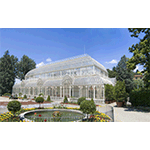Horticultural Garden
In 1852, the Accademia dei Georgofili of Florence, the first public society of agrarian studies in Europe, instructed a specially instituted commission headed by marquis Pietro Torrigiani, to found a horticultural society in Tuscany. In September of that same year, the commission instituted an exhibition in the Palazzo della Crocetta, as an "exploratory assay of the capability of Tuscans to cultivate Flower and Vegetable Gardens". The favourable outcome of the event led to the birth in 1854 of the Tuscan Society of Horticulture with the purpose of promoting "the love and taste for Horticulture; and primarily through public shows and prizes". It was also the responsibility of the Society to create an experimental garden to promote "knowledge of good horticultural practises". So it was that in 1859, marquis Ludovico Ginori Lisci, a member of the Society, offered a vast plot of land between the Mugnone and the via Bolognese, to plant an experimental garden. The first mother plants were donated by illustrious Tuscan horticulturalists and agronomists from the Museo di Fisica e Storia Naturale and from the Herb Garden of Florence. Finally, in 1862, the garden hosted the first horticultural show. A wooden pavilion lit by coloured lanterns, was built for the occasion on a project by engineer Alessandro Pasqui. Known as the "Chinese Pavilion", it gave the garden an Oriental flavour.
In 1880, the Italian Horticultural Federation chose the Horticultural Garden of Florence as the venue for the First National Exhibition. For the occasion, the Tuscan Horticultural Society sponsored the construction of a large tepidarium capable of sheltering the plants from subtropical and temperate climates. This is without a doubt the garden’s most spectacular structure. Realised by the Officine Michelucci of Pistoia on a project by architect Giacomo Roster, the work constituted an extraordinary example of architecture in iron and glass that was emerging on the national panorama. The daring building with its metal structure supported by 24 cast-iron columns is situated more or less on the spot where the "Chinese Pavilion" had stood only a few years before. The tepidarium stimulated the interest for botanical research and experimentation in greenhouse cultivating.
The initiatives held in the garden accompanied several significant moments for the community, such as the 1887 exhibition organised for the unveiling of the facade of the Cathedral of Florence. With its various greenhouses, the garden attempted to round off its experimental activities in horticulture in those years with the creation of specific areas for ornamental plants. The International Floricultural Exhibition of 1911, organised in conjunction with the fifty-year anniversary of the proclamation of the Kingdom of Italy, involved radical modifications to the garden’s layout. In the central area, the Manifattura di Signa built the elegant Loggetta Bondi. Following a period of gradual decline, in 1931 the area was purchased by the Commune which implemented a rehabilitation project.
Today, the garden has many high-trunk trees, flower-beds, and a children’s playground. Following recent restoration, Roster’s tepidarium has returned to its original splendour.
****************************
Texts by Graziano Magrini
English translation by Victor Beard
Last update 17/lug/2012





